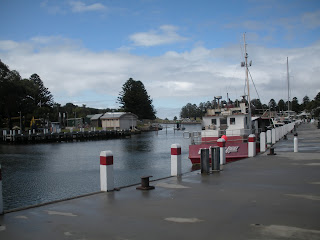 A suggestion from our family prompted us to go south into the Alpine Region of the Great Dividing Range for a few days, and it proved to be well worthwhile.
A suggestion from our family prompted us to go south into the Alpine Region of the Great Dividing Range for a few days, and it proved to be well worthwhile.  Passing through Beechworth, we discovered that not only was Ned Kelly arraigned there, he was brought up locally. We had a guided historic tour, where we also learned that Burke of Burke and Wills fame spent a few years as police chief before his ill fated expedition north to the gulf of Carpenteria. The police office and the gaol have been preserved, and we were able to see uniforms and documents from that era.
Passing through Beechworth, we discovered that not only was Ned Kelly arraigned there, he was brought up locally. We had a guided historic tour, where we also learned that Burke of Burke and Wills fame spent a few years as police chief before his ill fated expedition north to the gulf of Carpenteria. The police office and the gaol have been preserved, and we were able to see uniforms and documents from that era. Bright is a lovely resort area favoured by Ausies from as far away as Melbourne and Sydney, at this time of year the trees are showing a colourful palette of reds, browns and greens as the deciduous trees begin to shed their leaves. We are quite high up here, maybe 2500 ft, probably the highest we have been in all our travels to date, but as this area was mainly settled by the British, they brought along many trees from home.
Bright is a lovely resort area favoured by Ausies from as far away as Melbourne and Sydney, at this time of year the trees are showing a colourful palette of reds, browns and greens as the deciduous trees begin to shed their leaves. We are quite high up here, maybe 2500 ft, probably the highest we have been in all our travels to date, but as this area was mainly settled by the British, they brought along many trees from home. Beleive it or not, we decided to take a bike ride along a disused rail track, we hired a tandem so that Anne could take it easy, travelling 20km to a winery and back. It was a lovely ride, but we were both complaining that a certain part of our anatomy was suffering badly when we arrived back!
Beleive it or not, we decided to take a bike ride along a disused rail track, we hired a tandem so that Anne could take it easy, travelling 20km to a winery and back. It was a lovely ride, but we were both complaining that a certain part of our anatomy was suffering badly when we arrived back!  In the afternoon we took a motor trip up Mount Buffalo, little knowing how steep and windy the road would be. It was 45km to the top, probably only 10k from Bright as the crow flies. Was it worth it? By hell it was! We climbed to over 6000 ft, and the views from the top were superb, we could see the hills and mountains for at least 40 miles, and the varied views on the way up were just great. I just wish I had the space here to show you everything.
In the afternoon we took a motor trip up Mount Buffalo, little knowing how steep and windy the road would be. It was 45km to the top, probably only 10k from Bright as the crow flies. Was it worth it? By hell it was! We climbed to over 6000 ft, and the views from the top were superb, we could see the hills and mountains for at least 40 miles, and the varied views on the way up were just great. I just wish I had the space here to show you everything. Many of the trees around us as we drove appeared to be dead, there had been a huge wildfire here in 2005, caused by lightning, killing off many of the trunks. However, the roots survived, and were regenerating the forests just as they had over millenia before.
Many of the trees around us as we drove appeared to be dead, there had been a huge wildfire here in 2005, caused by lightning, killing off many of the trunks. However, the roots survived, and were regenerating the forests just as they had over millenia before. While here we visited the Bright Rotary club, where we were made most welcome. We learned that they have two main fund raisers, a weekly market, and a water slide that they man only for the two summer months of January and February, making £25,000 a year. With the market they earn over $100,000 each year, makes me green with envy!
While here we visited the Bright Rotary club, where we were made most welcome. We learned that they have two main fund raisers, a weekly market, and a water slide that they man only for the two summer months of January and February, making £25,000 a year. With the market they earn over $100,000 each year, makes me green with envy!If you think my smile is not up to it's usual standard, you would be right. I lost a tooth the day before, and there is no dentist here. So my smile is not as "Bright" as normal........













































